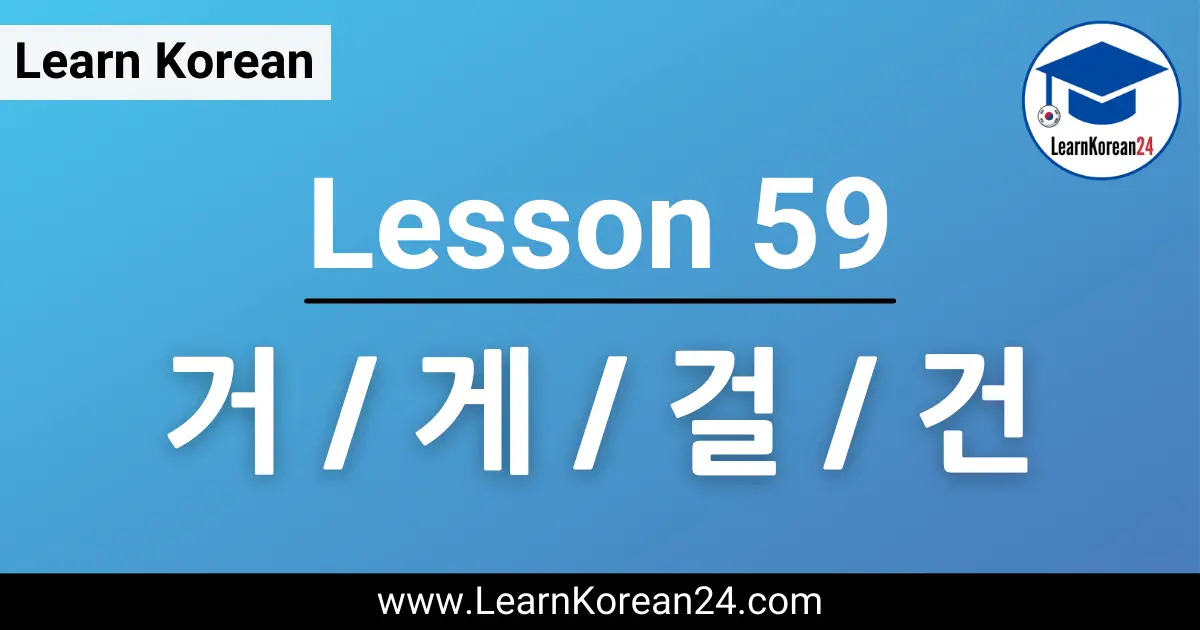Lesson 59: 거 / 게 / 걸 / 건
In this lesson, you will learn how to combine the bound noun 것 with particles 이 / 을 / 은. If you’ve been doing the lessons from this course in order, you might remember 것 from lesson 37. In lesson 37, you learned how to say ‘this’ (이) and ‘that’ (그/저) in Korean and how you can combine these with the word for ‘thing’ (것) to say things like “this thing”, “that thing”, “that thing over there”. In this lesson, you’ll learn how to make your sentences sound more natural by combining 것 with particles 이 / 을 / 은 to form 게 / 걸 / 건. First, let’s quickly review the meaning of 것.
Lesson 59: 거 / 게 / 걸 / 건
KEY INFORMATION
거 = ‘thing’ (거 is the shortened form of 것)
게 = 것 + subject particle 이
걸 = 것 + object particle 을
건 = 것 + topic particle 은
것 = 거
것 means ‘thing’, ‘object’, or ‘affair’, and is the most commonly occurring bound noun in Korean. By ‘bound noun’, we mean that it cannot be used alone as it must always be used in conjunction with another noun. 것 is usually shortened to 거 in conversations. Here are some example sentences with 것 / 거:
이 가방은 제 거예요. (=이 가방은 제 것이에요.) = This bag is mine.
이 책은 수아 씨 거예요. (=이 책은 수아 씨의 것이에요.) = This book is Sua’s.
저 책은 누구 거예요? (=저 책은 누구의 것이에요?) = Whose is that book over there?
저 책은 선생님 거예요. (=저 책은 선생님의 것이에요.) = That book over there is my teacher’s.
이거는 커피예요. (=이것은 커피예요.) = This is coffee.
저거는 시계예요. (=저것은 시계예요.) = That over there is a clock.
그거는 뭐예요? (=그것은 뭐예요?) = What’s that?
게 / 걸 / 건
When 것 is combined with the particles 이 / 을 / 은, the combined forms 것이 / 것을 / 것은 are often shortened to 게 / 걸 / 건. Let’s look at some examples.
그게 맛있어요? (=그것이 맛있어요?) = Is that delicious?
네, 맛있어요. = Yes, it is.
이거하고 저거 중에 뭐 보고 싶어요? = Between this one and that one, which one would you like to watch?
저걸 보고 싶어요. (=저것을 보고 싶어요.) = I would like to watch that one.
이건 뭐예요? (=이것은 뭐예요?) = What’s this?
이건 지갑이에요. (=이것은 지갑이에요.) = This is a wallet.
시간이 있을 때 뭐 해요? = What do you do when you have spare time?
산책하는 걸 좋아해요. (=산책하는 것을 좋아해요.) = I like going for a walk.
Review
In this short lesson, you learned that 것 combined with the particles 이 / 을 / 은 becomes 것이 / 것을 / 것은, and when these are shortened in conversations, they become 게 / 걸 / 건. Using these shortened forms in conversations will make your Korean sentences sound more natural.

